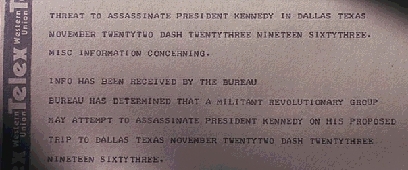The JFK 100
The Vanished Telex

Did the FBI have advance warning of the assassination?

Did the FBI have advance warning of the assassination?
William Walter told Jim Garrison in 1968 that he had seen such a teletype, but he could not produce a copy of it. Rather, he composed a mock teletype that he said reconstructed the original as best he could remember. After the assassination, Walter said, the telex disappeared from all files in all of the FBI's offices, and Walter claims he was instructed by his superiors never to mention it to anyone.Holds up the telex. We see a close-up: "URGENT TO ALL SACS [Special Agents in Charge] FROM DIRECTOR."JIM I think we can raise the possibility that Oswald not only was an [FBI] informant but that he may well have been the original source for the telex we have dated November 17 warning of the Kennedy assassination in Dallas on November 22.
FLASHBACK TO New Orleans FBI office in 1963. Walter, the night clerk, receives the teletype, reads it, and runs it.JIM (CONT'D) William Walter, the night clerk on duty here in the FBI office, gave me a copy of this. It went all over the country. Nothing was done, and the motorcade went ahead on schedule -- and this wasn't even mentioned in the Warren Report! Read it, Al.
AL [OSER] (VOICE OVER) "Threat to assassinate President Kennedy in Dallas, Texas, November 22-23. Information received by the Bureau has determined that a militant revolutionary group may attempt to assassinate President Kennedy on his proposed trip to Dallas, Texas, etc, etc. . . ."
JIM (V. O.) . . . shortly after the assassination, Walter says, the telex was removed from all the files in all cities, as an obvious embarrassment to the Bureau.(1)
A decade later the House Select Committee investigating the JFK assassination (HSCA) looked into the story. The Committee writes:
Walter admitted that he did not publicly allege the existence of this telephone until 1968. At that time, the FBI instituted an investigation that failed to find any corroboration for Walter's story. According to the Bureau, no record of a teletype or any other kind of communication reporting that there would be an attempt to assassinate President Kennedy in Texas could be found. Over 50 FBI employees of the New Orleans FBI office were interviewed by the Bureau, and none of them stated that they had any knowledge of any such teletype. . . .By the time he spoke with the HSCA, Walter's story had also grown considerably. He now claimed that he also had seen documents proving that Lee Harvey Oswald had been an FBI informant. That story, however, has been debunked.Walter advised the committee that he did not know of anyone who could definitely substantiate his teletype allegation, although he suggested that his former wife, Sharon Covert, who also had worked for the FBI in New Orleans, might be able to do so. Sharon Covert, however, advised the committee that she could not support any of Walter's allegations against the FBI and that Walter had never mentioned his allegations to her during their marriage.
More fundamentally, however, the committee was led to distrust Walter's account of the assassination teletype because of his claim that it had been addressed to the special agents in charge of every FBI field office. The committee found it difficult to believe that such a message could have been sent without someone 15 years later -- a special agent in charge or an employee who might have seen the teletype -- coming forward in support of Walter's claim. The committee declined to believe that that many employees of the FBI would have remained silent for such a long time. Instead, the committee was led to question Walter's credibility. The committee concluded that Walter's allegations were unfounded.(2)
Walter specifically claimed that Oswald had been the informant who alerted the FBI to the existence of a cache of arms being stored at the New Orleans residence of William McLaney, which the FBI seized on July 31, 1963. The arms cache had nothing to do with the Kennedy assassination, but Jim Garrison had begun claiming otherwise in 1967; Garrison insisted that the arms cache was relevant to the assassination, though he was vague as to the precise link.
At any rate, there is no doubt that William Walter is lying; declassified documents prove that Lee Oswald was not the informant for the McLaney raid. While the individual's name is still classified, he was reporting to the FBI in Miami -- not to William Walter's New Orleans office -- and is described in one document as "a Miami businessman with numerous contacts among the Cuban population of South Florida . . ."(3)
One could theorize that Walter bears a grudge against the FBI, with which organization he parted company after being disciplined for "demonstrating atrocious judgment concerning activities while in a sick leave status," and for "failure to properly record telephonic complaints received from a woman who, in turn, claimed that [Walter] had called her with obscene propositions. No evidence was actually established that Walter made these calls."(4)
Regardless of why he fabricated his tales, however, there is little doubt but that all of William Walter's tales are concocted.
NOTES:1. Oliver Stone and Zachary Sklar, JFK: The Book of the Film (New York: Applause, 1992), pp. 133. All quotations are from the shooting script and may vary slightly from the finished motion picture.
2. Final Report of the Subcommittee on the Assassination of John F. Kennedy of the Select Committee on Assassinations, House of Representatives, p. 192.
3. FBI Report of William Mayo Drew, Jr., August 8, 1963, JFK Record No. 180-10076-10241. Thanks to Jerry P. Shinley.
4. FBI Memo to Mr. W. C. Sullivan, Re: Assassination of President John F. Kennedy, February 1, 1968, JFK Record No. 124-10020-10479. Thanks to Denis Morissette.